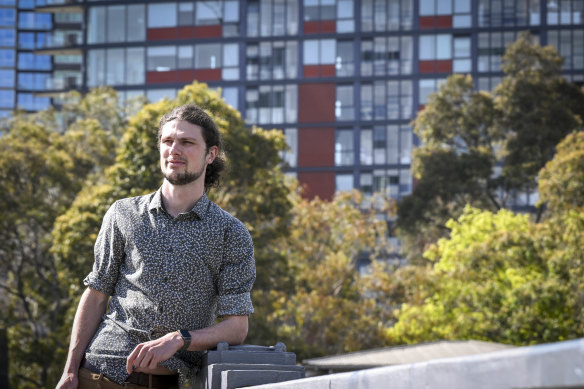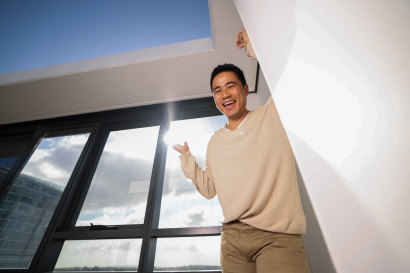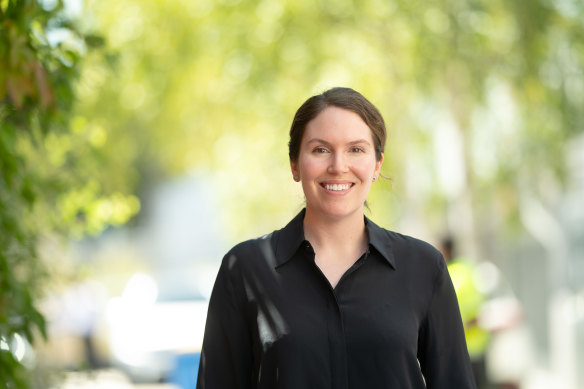- Exclusive
- Environment
- Climate change
- Renewables
This was published 7 months ago
A place in the sun: How to get solar to 2.5m apartment dwellers
By Caitlin Fitzsimmons and Bianca Hall
Australia has the highest uptake of rooftop solar in the world, but millions of apartment residents are not reaping the benefits of cheaper power and electrification.
The International Energy Agency reported this week that Australia has the most solar capacity per person in the world, closely followed by the Netherlands. Households with rooftop solar are providing 11.3 per cent of the nation’s total energy supply, SunWiz figures show, but most panels are on freestanding homes in the suburbs and regional towns.

Xanthorrhoea West has had short shrift trying to convince his body corporate to install solar panels.Credit: Eddie Jim
Across Australia, 2.5 million people live in a flat or apartment, with more again living in duplexes, townhouses and villas that can be under strata title. Owners must get their owners’ corporation on board, and the structures of buildings can make individual solar ownership a practical impossibility.
Thirty per cent of Australian households are renters, including Xanthorrhoea West, who lives in an apartment in Fairfield in Melbourne’s inner north-east.
West said he would love his block to have solar panels and a shared EV charging station, but being a renter, the owners’ corporation was “unfortunately … not that interested in speaking to me about it”.
“I have tried to let my landlord know about the ability to install solar panels for free [with the Victorian government’s rebate],” West said. “And the message I got, quite quickly, was that my landlord is not interested in getting free solar panels.”

Rob Chan at his North Sydney apartment building.Credit: Dylan Coker
Nor is it straightforward for owner-occupiers in a strata dwelling.
Rob Chan, who owns an apartment in a modern 18-storey building in North Sydney, said he had been working with his owners’ corporation for more than a year to try to install communal solar panels.
The owners’ corporation took advantage of a council program to use an independent consultant to examine the building’s energy profile and suggest options, Chan said.
The consultant recommended panels to power shared electricity usage including lighting in hallways and electric barbeques and gym equipment in the common area on the roof. This would then reduce the strata fees paid by all apartment owners, providing payback to both owner-occupiers and landlords within four and a half years, even without storage batteries.
While Chan said there was a general willingness among his neighbours, the owners’ corporation only met quarterly and there were other priorities, such as leaks in the basement.
“Across the board, everyone sees the economic benefits,” Chan said. “There is endorsement from the chair and broad agreement that this is a sensible thing for us to do … but other more urgent issues are taking up the owners’ corporation’s time.”
In 2024, just 3.3 per cent of strata schemes in Greater Sydney have rooftop solar compared to a third of residential houses, a report by Solar Citizens with Electrify Wolli Creek says.
Yet in large buildings such as high-rise apartments, the report says, up to 60 per cent of energy consumption comes from common areas and shared services, and about 25 per cent of administrative fund strata levies are spent on energy bills alone.
Solar uptake around the world
- Australia: 1296 Wp per capita
- The Netherlands: 1288 Wp per capita
- Germany: 974 Wp per capita
- Belgium: 842 Wp per capita
- Spain: 806 Wp per capita
(Wp or “watt peak” refers to the maximum power that can be produced by a photovoltaic panel under standard temperature and sunlight conditions). Source: International Energy Agency
One obstacle identified in the report is that owners’ corporations and strata committees often lack the required technical understanding and knowledge of the various rebates and grants.
The federal government is investing $100 million in a community solar banks program, where city dwellers buy shares in a regional solar facility, such as the Haystacks Solar Garden in Grong Grong in the Riverina.
The government program will subsidise shared ownership for up to 25,000 households who can’t install their own systems, including renters, apartment dwellers and low-income households.
In Victoria, a solar rebate scheme for apartment owners run by the state and federal governments was so popular a second round of grants was announced in August. It was also expanded to include other strata properties such as townhouses, villas and units.
Under the $32 million scheme, apartment residents could apply for up to $2800 per apartment or up to $140,000 for buildings of up to 50 apartments. When the scheme is exhausted in December, 15,000 apartments will be powered by solar.
Karen Stiles, executive director of the Owners Corporation Network of Australia, said she hoped the NSW government would roll out a similar grants scheme for apartment dwellers.
“It’s complex, and governments are not grappling with that and supporting the people that they’re shoving into more and more high density around Australia,” Stiles said.
The NSW government did not respond to inquiries.
Caroline Pribble, who owns an apartment in Kew, was keen to take advantage of the Victorian government’s grants for solar, but residents were blocked by a group of commercial tenants.

Kew resident Caroline Pribble says commercial tenants vote differently from most residents on solar panels.
“We have a small apartment building with less than 15 units, and we have a couple of commercial units that weren’t interested in solar, which was a key problem for us because they have different priorities,” Pribble said. “All the commercial units voted no, and then the majority of the apartments did vote yes. So that was disappointing for us.”
In Germany, apartment dwellers can buy portable solar panels for about $500 that hang on the balcony railing and plug into the mains via a standard power socket. They can reduce the dwelling’s power usage or feed into the grid, and residents can take it with them when they move.

Portable solar panels on apartment balconies in Freiburg, Germany.Credit: Alamy Stock Photo
Half a million of these “balcony power plants” have been registered across Germany since May, when the government made changes to encourage adoption including increasing the maximum wattage from 600 to 800 and enshrining a principle that the landlord must consent. The College of Engineers also changed the standard to enable it to be plugged into a standard power outlet.
Clean Energy Council co-chief policy and impact officer Con Hristodoulidis said a proponent who wanted to import the panels would have to pass the council’s product accreditation program to ensure they adhere to Australian safety standards.
SunWiz managing director Warwick Johnston said: “I would love to see that coming to Australia. I think we need to see something where it’s easy for renters to bring your own panels.”
Get to the heart of what’s happening with climate change and the environment. Sign up for our fortnightly Environment newsletter.